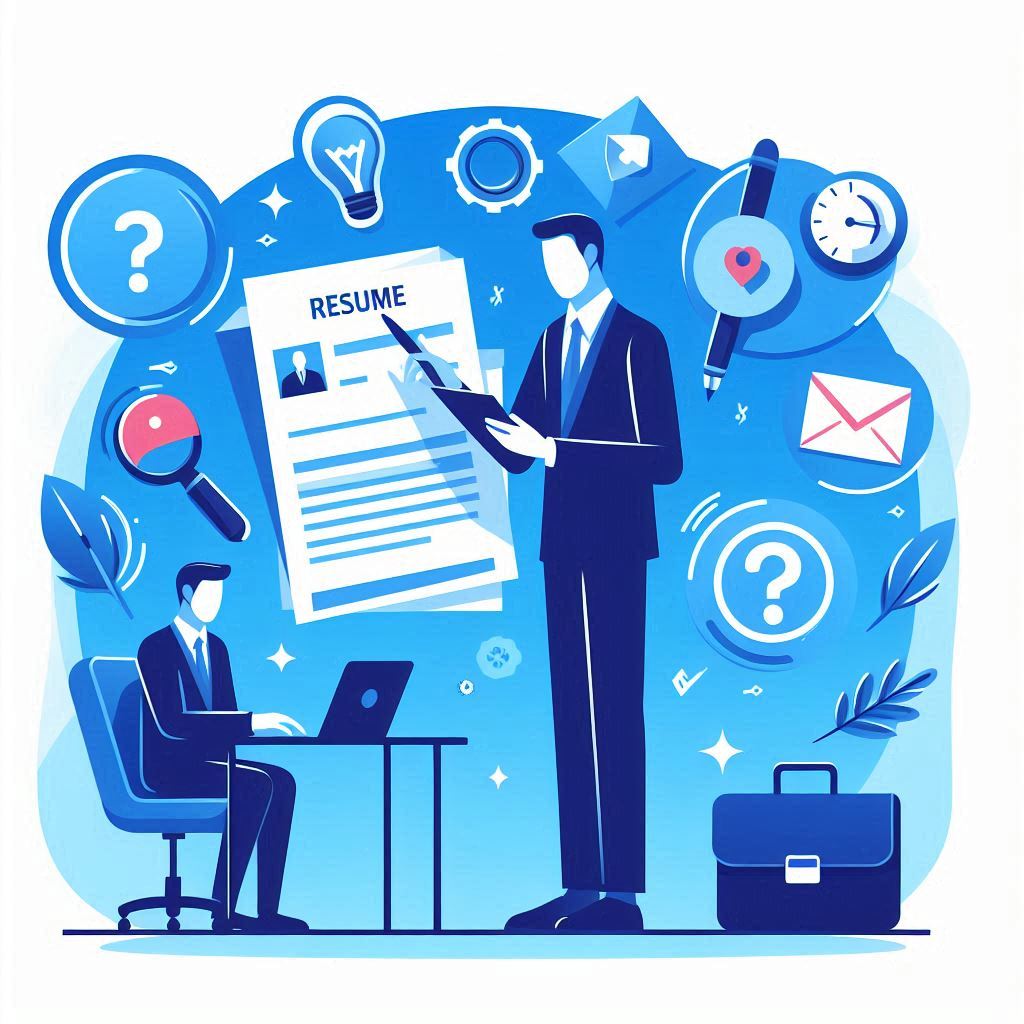Editor's Pick
ATS Keyword Optimization Mastery: Free AI Resume Builder Guide
Master the science of ATS keyword optimization with comprehensive strategies that get your resume past digital screening and into human hands. Learn the four critical keyword types, discover the proven IMPACT placement method, and avoid common mistakes that kill your chances. Get industry-specific optimization techniques, advanced integration strategies, and systematic testing methods to ensure your keywords work across all ATS platforms. Transform your job search from automated rejection to interview opportunities with strategic keyword mastery.
ATS Keyword Optimization Mastery: Free AI Resume Builder Guide
Your resume could be perfect for the job, but if it lacks the right keywords, ATS software will never send it to human recruiters. With 75% of companies using keyword-based screening, mastering ATS keyword optimization isn't optional—it's essential for job search success.
The challenge isn't just finding keywords; it's integrating them naturally while maintaining compelling content. Most job seekers either stuff keywords unnaturally or miss critical terms entirely, both of which hurt their chances.
💡 Skip the keyword guesswork. 1Template's AI resume builder automatically identifies and optimizes keywords for your target role. Get 20 free credits and create perfectly optimized resumes in minutes.
How ATS Keyword Analysis Really Works
Understanding ATS keyword processing helps you optimize strategically rather than randomly sprinkling terms throughout your resume.
The Three-Stage ATS Keyword Process
Stage 1: Resume Parsing
ATS systems convert your resume into structured data, extracting information into categories like work experience, education, and skills. Poor formatting can cause critical keywords to be missed or misclassified during this stage.
Stage 2: Keyword Matching
The system compares extracted text against job description requirements using several matching techniques:
Exact matching: Looking for precise phrase matches from job descriptions
Semantic matching: Understanding related terms and synonyms
Context analysis: Evaluating how keywords are used within sentences
Proximity scoring: Measuring how closely related keywords appear together
Stage 3: Relevance Scoring
ATS assign scores based on multiple factors:
Keyword frequency and distribution
Placement within important sections (summary, skills, experience)
Context and professional usage
Required vs. preferred qualification matches
Industry-specific terminology usage
Modern ATS Sophistication Levels
Basic Systems: Rely primarily on exact keyword matches and may miss synonyms or context
Advanced Systems: Use AI and natural language processing to understand context, synonyms, and skill relationships
Enterprise Platforms: Incorporate machine learning to improve matching accuracy and reduce false positives
💡 Smart Optimization: 1Template's AI understands all ATS sophistication levels and optimizes your keywords for maximum compatibility across platforms.
The Four Types of ATS Keywords You Must Master
Effective keyword optimization requires understanding different keyword categories and their strategic importance.
1. Hard Skills Keywords (Highest ATS Weight)
Technical abilities and specific competencies that ATS prioritize most heavily:
Software and Tools:
Specific software names: "Salesforce," "Adobe Creative Suite," "QuickBooks"
Programming languages: "Python," "JavaScript," "SQL"
Platforms and systems: "AWS," "Microsoft Azure," "SAP"
Industry-specific tools: "AutoCAD," "Tableau," "HubSpot"
Certifications and Credentials:
Professional certifications: "PMP," "CPA," "Six Sigma Black Belt"
Technical certifications: "AWS Certified," "Google Analytics Certified"
Industry licenses: "RN," "PE," "Series 7"
Methodologies and Frameworks:
Project management: "Agile," "Scrum," "Waterfall"
Quality standards: "ISO 9001," "HIPAA compliance," "SOX"
Business frameworks: "Lean Six Sigma," "Design Thinking"
2. Job Function Keywords (High ATS Weight)
Specific responsibilities and activities mentioned in job descriptions:
Management functions: "team leadership," "budget management," "strategic planning"
Analytical tasks: "data analysis," "market research," "financial modeling"
Communication activities: "stakeholder management," "client presentations," "cross-functional collaboration"
Operational responsibilities: "process optimization," "quality assurance," "vendor management"
3. Industry-Specific Keywords (Medium ATS Weight)
Terminology that demonstrates industry knowledge and experience:
Healthcare: "EHR," "patient care protocols," "clinical documentation," "quality metrics"
Technology: "API development," "cloud migration," "cybersecurity," "DevOps"
Finance: "risk management," "regulatory compliance," "portfolio management," "financial reporting"
Marketing: "lead generation," "conversion optimization," "brand strategy," "customer acquisition"
4. Soft Skills Keywords (Lower ATS Weight, High Human Value)
Interpersonal and leadership qualities that matter more to human reviewers:
Leadership qualities: "team building," "mentoring," "change management"
Communication skills: "public speaking," "written communication," "negotiation"
Problem-solving abilities: "critical thinking," "analytical reasoning," "innovation"
Adaptability traits: "flexibility," "continuous learning," "adaptability"
⚡ Automatic Keyword Categorization: 1Template identifies and categorizes the most impactful keywords for your specific role and industry automatically.
Strategic Keyword Research: Beyond Job Descriptions
Effective keyword optimization starts with comprehensive research that goes beyond single job postings.
The Multi-Source Research Strategy
Primary Sources:
Step 1: Target job descriptions - Analyze 5-10 similar roles for common keywords
Step 2: Company career pages - Review how companies describe roles and requirements
Step 3: Industry job boards - Identify trending terminology in your field
Step 4: Professional association sites - Find industry-standard terminology
Secondary Sources:
Step 1: LinkedIn profiles - Review successful professionals in target roles
Step 2: Industry publications - Identify emerging terminology and trends
Step 3: Conference agendas - Spot cutting-edge topics and skills
Step 4: Certification bodies - Find relevant credential terminology
Advanced Keyword Analysis Techniques
Frequency Analysis:
Track how often specific keywords appear across multiple job postings
Identify "must-have" vs. "nice-to-have" keywords based on frequency
Prioritize keywords that appear in job titles and requirements sections
Competitive Analysis:
Research keywords used by professionals who land roles you want
Analyze LinkedIn profiles of recently hired candidates
Identify keyword gaps in your current resume
Trend Analysis:
Monitor emerging skills and technologies in your industry
Track evolving job requirements and terminology changes
Anticipate future keyword trends based on industry direction
Creating Your Master Keyword Database
Organize discovered keywords into a strategic database:
Tier 1 Keywords (Critical):
Required qualifications that appear in 80%+ of target job descriptions
Core technical skills for your field
Essential certifications or credentials
Tier 2 Keywords (Important):
Preferred qualifications appearing in 50-80% of descriptions
Industry-specific terminology and methodologies
Relevant software and tools
Tier 3 Keywords (Valuable):
Emerging skills and technologies
Soft skills and leadership qualities
Additional certifications and training
Strategic Keyword Placement: The IMPACT Method
Where you place keywords matters as much as which keywords you choose. Use the IMPACT method for optimal placement:
I - Introduction (Professional Summary)
Strategy: Front-load your most important keywords in the first 50 words
Placement: Include 4-6 Tier 1 keywords naturally within your value proposition
Example: "Digital Marketing Manager with 7+ years driving lead generation campaigns using HubSpot, Google Analytics, and marketing automation. Expert in SEO optimization, content strategy, and conversion rate optimization with proven track record of increasing qualified leads by 150%."
M - Main Skills Section
Strategy: Create a dedicated, scannable skills repository
Organization:
Technical Skills: Software, programming languages, tools
Industry Skills: Methodologies, frameworks, specialized knowledge
Leadership Skills: Management and interpersonal abilities
Format Example:
"Technical Skills: Salesforce CRM, HubSpot, Google Analytics, SQL, Tableau
Marketing Expertise: Lead generation, content marketing, SEO/SEM, marketing automation
Leadership: Team management, cross-functional collaboration, strategic planning"
P - Professional Experience
Strategy: Integrate keywords within achievement contexts using the CAR method
CAR Framework: Challenge + Action (keyword-rich) + Result
Example: "Facing declining customer retention rates, implemented automated email marketing campaigns using HubSpot and personalized content strategies, resulting in 35% improvement in customer lifetime value and $600K additional revenue."
A - Achievements and Accomplishments
Strategy: Highlight quantified results using relevant terminology
Structure: Action verb + keyword-rich process + quantified outcome
Examples:
"Optimized Google Ads campaigns, reducing cost-per-acquisition by 40% while increasing conversion rates by 25%"
"Led Agile development team through complex API integration project, delivering ahead of schedule and under budget"
C - Certifications and Education
Strategy: Include relevant coursework, projects, and continuing education
Optimization:
List specific certification names and issuing organizations
Include relevant coursework that aligns with job requirements
Mention thesis topics or major projects using industry keywords
T - Additional Sections (When Space Allows)
Strategic additions:
Professional Associations: Industry membership demonstrates commitment
Publications/Speaking: Thought leadership keywords
Volunteer Work: Additional skill demonstration opportunities
Languages: Global business keywords when relevant
🚀 IMPACT Method Automation: 1Template's AI automatically applies the IMPACT method, placing your keywords in optimal locations for maximum ATS impact.
Advanced Keyword Optimization Techniques
Take your keyword strategy beyond basics with sophisticated optimization methods.
Semantic Keyword Clustering
Group related keywords to create comprehensive skill coverage:
Digital Marketing Cluster:
Primary: "digital marketing," "online marketing," "internet marketing"
Related: "SEM," "SEO," "social media marketing," "content marketing"
Tools: "Google Analytics," "HubSpot," "Mailchimp," "Hootsuite"
Metrics: "conversion rates," "CTR," "ROI," "lead generation"
Project Management Cluster:
Primary: "project management," "program management," "project coordination"
Related: "Agile," "Scrum," "Waterfall," "Kanban"
Tools: "Microsoft Project," "Jira," "Asana," "Trello"
Skills: "risk management," "stakeholder communication," "budget management"
Context-Driven Keyword Integration
Integrate keywords naturally within professional contexts:
Weak Integration: "Experienced in Java, Python, SQL, project management, and team leadership."
Strong Integration: "Led cross-functional development teams using Agile methodologies to deliver Java and Python applications, utilizing SQL databases and implementing automated testing frameworks that reduced deployment time by 50%."
Keyword Variation and Synonym Strategy
Use multiple forms of important concepts to maximize matching:
Customer Service: "customer service," "client relations," "customer support," "customer experience," "client satisfaction"
Analysis: "data analysis," "analytical skills," "data insights," "statistical analysis," "business intelligence"
Leadership: "team leadership," "team management," "supervisory experience," "staff development," "people management"
Industry-Specific Optimization Strategies
Technology Sector:
Include specific version numbers: "React 18," "Python 3.9," "AWS Lambda"
Reference methodologies: "DevOps," "CI/CD," "Test-Driven Development"
Mention scale: "microservices architecture," "high-traffic applications," "distributed systems"
Healthcare Industry:
Emphasize compliance: "HIPAA compliance," "Joint Commission standards," "CMS guidelines"
Include specializations: "acute care," "ambulatory care," "emergency medicine"
Reference systems: "Epic," "Cerner," "MEDITECH," "electronic health records"
Financial Services:
Regulatory keywords: "SOX compliance," "Basel III," "Dodd-Frank," "anti-money laundering"
Technical skills: "financial modeling," "risk assessment," "portfolio management"
Software: "Bloomberg Terminal," "Reuters," "FactSet," "Morningstar"
Avoiding Critical Keyword Mistakes
Common keyword optimization errors that hurt both ATS performance and human readability.
The Keyword Stuffing Trap
Problem: Overusing keywords makes content unreadable and can trigger ATS spam filters
Warning Signs:
Repeating the same keyword multiple times in a single bullet point
Unnatural language flow and awkward phrasing
Keywords appearing without proper context
Identical phrases repeated across different sections
Solution: Use keywords naturally within meaningful achievement descriptions
The Acronym Confusion
Problem: Using only acronyms or only full terms, missing matching opportunities
Best Practice: Include both forms strategically
First mention: "Search Engine Optimization (SEO)"
Subsequent mentions: Use variations naturally
Skills section: Include both forms if space allows
The Generic Skills Mistake
Problem: Using vague terms instead of specific, searchable keywords
Weak Examples:
"Good with computers" → "Proficient in Microsoft Office Suite, Salesforce CRM, and Google Workspace"
"Marketing experience" → "Digital marketing, content strategy, lead generation, and marketing automation"
"Management skills" → "Team leadership, project management, and strategic planning"
The Outdated Terminology Error
Problem: Using outdated terms that modern job descriptions don't include
Solution: Stay current with industry language evolution
Research current job postings for terminology trends
Follow industry publications and thought leaders
Attend professional development events and webinars
Update keywords quarterly based on market changes
⚠️ Mistake Prevention: 1Template's AI automatically prevents keyword optimization mistakes while maintaining natural, professional language throughout your resume.
Testing and Measuring Keyword Effectiveness
Implement systematic testing to optimize your keyword strategy continuously.
ATS Simulation Testing
Free Testing Tools:
JobScan: Comprehensive keyword analysis against specific job descriptions
Resume Worded: AI-powered optimization suggestions and scoring
SkillSyncer: Keyword gap identification and recommendations
Testing Protocol:
Step 1: Test against 3-5 target job descriptions
Step 2: Analyze keyword match percentages and gaps
Step 3: Review suggestions for missing critical terms
Step 4: Implement improvements and retest
Step 5: Compare performance across different tools
Manual Keyword Audit Process
Step-by-Step Audit:
Step 1: Keyword Inventory - List all keywords currently in your resume
Step 2: Job Requirement Mapping - Match your keywords against target job requirements
Step 3: Gap Analysis - Identify missing critical keywords
Step 4: Placement Review - Evaluate keyword distribution across resume sections
Step 5: Context Assessment - Ensure keywords appear in meaningful contexts
Performance Tracking Metrics
Quantitative Measures:
Application response rates (target: 20-30%)
Interview conversion rates
Time from application to initial contact
Keyword match percentages in testing tools
Qualitative Indicators:
Quality of recruiter feedback and questions
Relevance of interview topics to your resume content
Recruiter understanding of your qualifications
Alignment between opportunities offered and your goals
A/B Testing Your Keyword Strategy
Testing Methodology:
Step 1: Create two resume versions with different keyword approaches
Step 2: Apply to similar roles using each version
Step 3: Track response rates and feedback quality
Step 4: Analyze which keywords generate better results
Step 5: Iterate based on performance data
Variables to Test:
Keyword density levels
Technical vs. soft skill emphasis
Industry-specific terminology variations
Achievement quantification approaches
Industry-Specific Keyword Mastery
Tailor your keyword strategy to industry-specific ATS configurations and hiring patterns.
Technology and Software Development
High-Priority Keywords:
Programming Languages: Include specific versions and frameworks
Development Methodologies: Agile, Scrum, DevOps, CI/CD
Cloud Platforms: AWS, Azure, Google Cloud Platform
Databases: SQL, NoSQL, specific database systems
Tools: Git, Docker, Kubernetes, Jenkins
Optimization Strategy:
Include both legacy and cutting-edge technologies
Specify experience levels and project scales
Reference open-source contributions and portfolios
Quantify technical achievements with performance metrics
Healthcare and Medical Fields
Critical Keywords:
Licenses and Certifications: Include numbers and expiration dates
Medical Specialties: Use precise clinical terminology
Healthcare Systems: Epic, Cerner, MEDITECH
Compliance: HIPAA, Joint Commission, CMS
Quality Metrics: Patient satisfaction, safety scores
Optimization Focus:
Emphasize patient care outcomes and safety metrics
Include continuing education and specialty training
Reference quality improvement initiatives
Highlight interdisciplinary collaboration experience
Sales and Business Development
Revenue-Focused Keywords:
CRM Systems: Salesforce, HubSpot, Pipedrive
Sales Methodologies: SPIN Selling, Challenger Sale, MEDDIC
Metrics: Quota attainment, revenue growth, pipeline management
Market Focus: B2B, B2C, enterprise sales, SMB
Relationship Building: Account management, client retention
Results Orientation:
Lead with revenue and growth achievements
Include territory size and market scope
Highlight customer retention and satisfaction metrics
Reference industry knowledge and vertical expertise
Your 5-Step Keyword Optimization Action Plan
Step 1: Research and Discovery (Day 1)
Analyze 5-7 target job descriptions for keyword patterns
Research successful LinkedIn profiles in your field
Identify industry-specific terminology and trends
Create master keyword database with priority tiers
Step 2: Current Resume Audit (Day 2)
Inventory existing keywords in your resume
Identify gaps compared to target job requirements
Evaluate current keyword placement and context
Test current resume with ATS simulation tools
Step 3: Strategic Integration (Day 3)
Apply IMPACT method for optimal keyword placement
Integrate Tier 1 keywords into professional summary
Enhance work experience with achievement-focused keywords
Optimize skills section with categorized keywords
Step 4: Optimization and Testing (Day 4)
Refine keyword density for natural flow
Test updated resume with multiple ATS tools
Verify readability and professional tone
Create both .docx and PDF versions
Step 5: Performance Tracking (Ongoing)
Monitor application response rates
Track interview conversion rates
Gather feedback from recruiters and interviews
Continuously update keywords based on market trends
Frequently Asked Questions
How many keywords should I include in my resume?
Focus on 15-20 highly relevant keywords distributed naturally throughout your resume. Quality and context matter more than quantity.
Should I include keywords I'm still learning?
Only include skills you can discuss confidently in an interview. Consider adding "developing proficiency in" for skills you're actively learning.
How often should I update my keywords?
Review and update keywords quarterly, and always customize for specific applications. Industries evolve rapidly, especially technology.
Can I use the same keywords for different job applications?
Use your master keyword database as a foundation, but customize emphasis and specific terms for each application based on the job description requirements.
What if my industry doesn't use many technical keywords?
Focus on action verbs, industry methodologies, soft skills, and quantifiable achievements. Every industry has its specialized terminology.
How do I handle keywords for career transitions?
Emphasize transferable skills and highlight any relevant coursework, projects, or volunteer work that demonstrates familiarity with your target field's keywords.
Master ATS Keyword Optimization Today
Join thousands who've cracked the keyword code and accelerated their job search success.
🚀 Optimize Keywords Automatically
✅ 20 Free Credits • ✅ AI Keyword Research • ✅ Strategic Placement • ✅ ATS-Optimized Results
Take Action: Transform Your Keyword Strategy
Don't let poor keyword optimization keep your qualifications hidden from recruiters. The difference between automated rejection and interview opportunities often comes down to strategic keyword placement and optimization.
Start optimizing your keywords today:
Step 1: Access 1Template's AI-powered keyword optimization
Step 2: Let our intelligent system research and identify optimal keywords for your role
Step 3: Get strategic placement recommendations based on ATS best practices
Step 4: Download your keyword-optimized resume in minutes
Step 5: Apply with confidence knowing your keywords are working for you
Your expertise deserves to be discovered by the right employers. Make sure your keywords open doors instead of closing them.
🎯 Ready to Master Keywords? Stop guessing at keyword optimization. Create your intelligently optimized resume with 1Template and join professionals who've mastered the science of keyword optimization with AI-powered precision.
Master ATS keyword optimization and watch your interview opportunities multiply. The right keywords, strategically placed, can transform your job search from frustrating silence to exciting opportunities.
© 2025 1Template. All rights reserved.
ATS keyword optimization isn't about gaming the system—it's about speaking the language that connects your qualifications with employer needs. The right keywords, strategically placed and naturally integrated, act as bridges between your expertise and the opportunities you deserve.
Success comes from understanding that keywords are more than search terms—they're the professional vocabulary that demonstrates your industry fluency and technical competence. When you master the IMPACT method and avoid common pitfalls, your resume becomes a powerful communication tool that works seamlessly with both ATS technology and human decision-makers.
The formula is proven: Research thoroughly, integrate naturally, test systematically, and optimize continuously. This approach transforms your resume from a document that might get noticed into one that consistently opens doors.
Stop letting poor keyword strategy hide your qualifications from the right opportunities. Master ATS keyword optimization, and watch your job search transform from frustrating silence to exciting possibilities.
Your career deserves keywords that work as hard as you do.
Build your own resume with 1template
Build your resume in 60 seconds with the most advanced AI-powered builder








